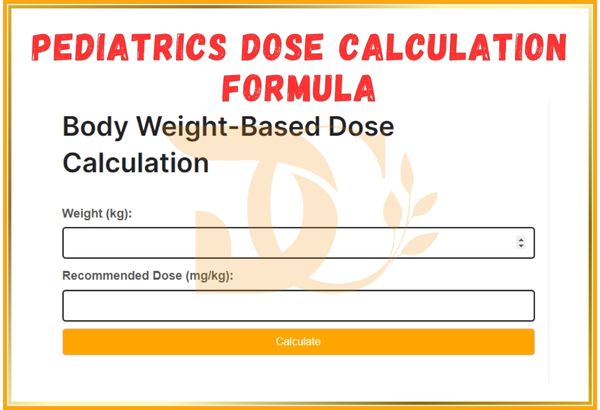On this page, we offer you a set of Dose Calculation Formula tools that you can use to verify those you perform in your daily practice or to assist you in your courses.
Dose Calculation Formula


Dose Calculation Formula
Calculating medication doses is a critical step in ensuring the safe and effective administration of medical treatments. Whether it’s determining the appropriate quantity of a medication based on body weight, body surface area, concentration, or the number of tablets, each calculation requires precise attention to avoid potentially dangerous errors.
Methods of Dose Calculation
- Weight-Based Dose Calculation This method is commonly used to adjust the medication dose based on the patient’s body weight. The basic formula is as follows:
Dose (in mg) = Weight (in kg) × Recommended Dose (in mg/kg)
For example, if a patient weighs 70 kg, and the recommended dose is 10 mg/kg, the calculated dose would be 700 mg.
- Body Surface Area-Based Calculation This method considers the patient’s body surface area to determine the appropriate dose. The general formula is as follows:
Dose (in mg) = Body Surface Area (in m²) × Recommended Dose (in mg/m²)
To calculate body surface area, the Dubois and Dubois formula is often used:
Body Surface Area (m²) = 0.007184 × Weight (kg)^0.425 × Height (cm)^0.725
- Concentration-Based Dose Calculation This method is used when the medication is administered in liquid form. The dose is calculated by multiplying the medication’s concentration by the recommended volume or mass. The formula is:
Dose (in volume or mass) = Medication Concentration (in mg/mL) × Recommended Volume or Mass (in mL or g)
- Tablet/Capsule Count-Based Dose Calculation This method is used when the medication is administered in tablet or capsule form. The dose is calculated by dividing the total required dose by the dose per tablet or capsule:
Number of tablets = Total Dose (in mg) / Dose per Tablet (in mg per tablet)
Important Precautions
Ensure an understanding of the units used in the formulas and convert them if necessary. Always check the specific recommendations for the medication and consult a healthcare professional if in doubt. Use precise and reliable calculation tools to avoid calculation errors.
Examples of Dose Calculations: Practice!
Example 1: Amoxicillin Dose Calculation
A doctor prescribes amoxicillin to a child weighing 20 kg. The recommended dose is 20 mg/kg. Calculate the appropriate dose for this child.
Solution: Let’s use the weight-based calculation formula.
Dose (mg) = Weight (kg) × Recommended Dose (mg/kg)
Dose = 20 kg × 20 mg/kg = 400 mg
The child should receive a 400 mg dose of amoxicillin.
Example 2: Tylenol Dose Calculation
An adult patient requires a 500 mg dose of Tylenol. The available tablets are dosed at 250 mg each. How many tablets should they take?
Solution: Let’s use the tablet count-based calculation formula again.
Number of tablets = Total Dose (mg) / Dose per Tablet (mg per tablet)
Number of tablets = 500 mg / 250 mg/tablet = 2 tablets
The patient should take 2 tablets of Tylenol to reach the required dose.
Example 3: Insulin Dose Calculation
A diabetic patient requires an insulin dose based on their blood sugar level. Their current level is 200 mg/dL, and the recommended dose is 0.05 units of insulin per mg/dL. Calculate the insulin dose to administer.
Solution: Let’s use the concentration-based calculation method.
Dose (units) = Concentration (units/mg) × Blood Sugar Level (mg/dL)
Dose = 0.05 units/mg × 200 mg/dL = 10 units
The patient should receive a 10 unit dose of insulin.
Example 4: Advil Dose Calculation
An adult needs a 300 mg dose of Advil for pain relief. The Advil tablets are dosed at 150 mg each. How many tablets should they take?
Solution: Let’s use the tablet count-based calculation formula again.
Number of tablets = Total Dose (mg) / Dose per Tablet (mg per tablet)
Number of tablets = 300 mg / 150 mg/tablet = 2 tablets
The patient should take 2 Advil tablets to achieve the necessary dose.
Example 5: Calculating mcg/kg/h
Dose Suppose we need to calculate the dose in mcg/kg/h for a child weighing 1.8 kg, receiving the following medication: fentanyl 5 mcg/mL at a rate of 0.72 mL/h.
First, we calculate the total mcg the child receives in one hour based on the rate: 5 mcg/mL x 0.72 mL/h = 3.6 mcg/h.
Then, we calculate the mcg per hour the child receives based on their weight: 3.6 mcg/h ÷ 1.8 kg = 2 mcg/kg/h.
In this example, the child receives a dose of 2 mcg of fentanyl per kilogram of body weight per hour.
Example 6: Caffeine Dose Calculation
Let’s assume we need to calculate the dose in mg/kg/day for a child weighing 1.5 kg, receiving the following medication: caffeine 7.5 mg orally once a day.
First, we multiply the dose to administer (7.5 mg) by the number of doses per day (1): 7.5 mg x 1 dose/day = 7.5 mg/day.
Then, we divide the total daily dose (7.5 mg/day) by the child’s weight in kg (1.5 kg): 7.5 mg/day ÷ 1.5 kg = 5 mg/kg/day.
In this example, the child receives a dose of 5 mg of caffeine per kilogram of body weight per day.
Example 7: Pediatric Dose Calculation
Let’s take the example of a child weighing 2.4 kg, receiving sildenafil at a dose of 1.2 mg orally four times a day.
First, we multiply the dose to administer (1.2 mg) by the number of doses per day (4): 1.2 mg x 4 doses/day = 4.8 mg/day.
Then, we divide the total daily dose (4.8 mg/day) by the child’s weight in kg (2.4 kg): 4.8 mg/day ÷ 2.4 kg = 2 mg/kg/day.
In this example, the child receives a dose of 2 mg of sildenafil per kilogram of body weight per day.

Leave a Reply